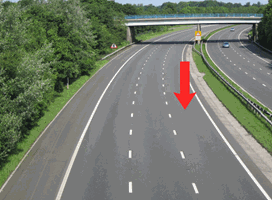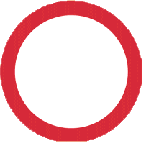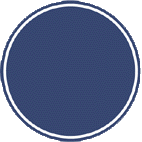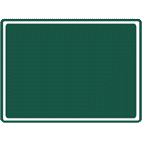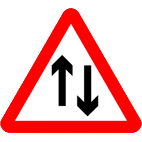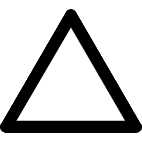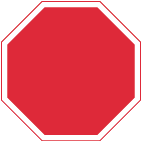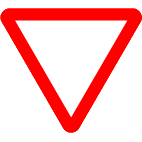You have 57 minutes to answer 50 multiple choice theory test questions. You need to answer at least 43 out of 50 questions correctly to pass. You can review your answer after each question or you can review all of your answers at the end of the test. Best of luck!
Test Quick View
Click on an answer to view the correct choice along with the explanation.
Correct Answer: B, C
Explanation: These markers must be fitted to vehicles over 13 metres long, large goods vehicles, and rubbish skips placed in the road. They are reflective to make them easier to see in the dark.
Explanation: These markers must be fitted to vehicles over 13 metres long, large goods vehicles, and rubbish skips placed in the road. They are reflective to make them easier to see in the dark.
2. You are waiting to come out of a side road. Why should you watch carefully for motorcycles?
Mark one answer
B
C
D
Correct Answer: A
Explanation: If you're waiting to emerge from a side road watch out for motorcycles: they're small and can be difficult to see. Be especially careful if there are parked vehicles restricting your view, there might be a motorcycle approaching. IF YOU DON'T KNOW, DON'T GO.
Explanation: If you're waiting to emerge from a side road watch out for motorcycles: they're small and can be difficult to see. Be especially careful if there are parked vehicles restricting your view, there might be a motorcycle approaching. IF YOU DON'T KNOW, DON'T GO.
Correct Answer: C
Explanation: You should normally use the left-hand lane on any dual carriageway unless you are overtaking or turning right. When overtaking on a dual carriageway, look for vehicles ahead that are turning right. They're likely to be slowing or stopped. You need to see them in good time so that you can take appropriate action.
Explanation: You should normally use the left-hand lane on any dual carriageway unless you are overtaking or turning right. When overtaking on a dual carriageway, look for vehicles ahead that are turning right. They're likely to be slowing or stopped. You need to see them in good time so that you can take appropriate action.
Correct Answer: C, D, E
Explanation: Looking well ahead and 'reading' the road will help you to anticipate hazards. This will enable you to stop safely at traffic lights or if ordered to do so by an authorised person.
Explanation: Looking well ahead and 'reading' the road will help you to anticipate hazards. This will enable you to stop safely at traffic lights or if ordered to do so by an authorised person.
Correct Answer: A
Explanation: Signs in the shape of a circle give orders. A sign with a red circle means that you aren't allowed to do something. Study Know Your Traffic Signs to ensure that you understand what the different traffic signs mean.
Explanation: Signs in the shape of a circle give orders. A sign with a red circle means that you aren't allowed to do something. Study Know Your Traffic Signs to ensure that you understand what the different traffic signs mean.
Correct Answer: B
Explanation: In order to keep roads free from parked cars, there are some areas where you're allowed to park on the verge. Only do this where you see the sign. Parking on verges or footways anywhere else could lead to a fine.
Explanation: In order to keep roads free from parked cars, there are some areas where you're allowed to park on the verge. Only do this where you see the sign. Parking on verges or footways anywhere else could lead to a fine.
Correct Answer: C
Explanation: A warning sign with a picture of a windsock will indicate there may be strong crosswinds. This sign is often found on exposed roads.
Explanation: A warning sign with a picture of a windsock will indicate there may be strong crosswinds. This sign is often found on exposed roads.
Correct Answer: C
Explanation: Harmful gases in the exhaust system pollute the atmosphere. These gases are reduced by up to 90% if a catalytic converter is fitted. Cleaner air benefits everyone, especially people who live or work near congested roads.
Explanation: Harmful gases in the exhaust system pollute the atmosphere. These gases are reduced by up to 90% if a catalytic converter is fitted. Cleaner air benefits everyone, especially people who live or work near congested roads.
9. You see a horse rider as you approach a roundabout. They are signalling right but keeping well to the left. You should
Mark one answer
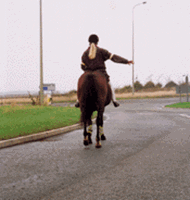
B
C
D
Correct Answer: D
Explanation: Allow the horse rider to enter and exit the roundabout in their own time. They may feel safer keeping to the left all the way around the roundabout. Don't get up close behind or alongside them. This is very likely to upset the horse and create a dangerous situation.
Explanation: Allow the horse rider to enter and exit the roundabout in their own time. They may feel safer keeping to the left all the way around the roundabout. Don't get up close behind or alongside them. This is very likely to upset the horse and create a dangerous situation.
10. You keep well back while waiting to overtake a large vehicle. A car fills the gap. You should
Mark one answer
B
C
D
Correct Answer: A
Explanation: It's very frustrating when your separation distance is shortened by another vehicle. React positively, stay calm and drop further back.
Explanation: It's very frustrating when your separation distance is shortened by another vehicle. React positively, stay calm and drop further back.
11. A horse rider is in the left-hand lane approaching a roundabout. You should expect the rider to
Mark one answer
B
C
D
Correct Answer: B
Explanation: Horses and their riders will move more slowly than other road users. They might not have time to cut across heavy traffic to take up positions in the offside lane. For this reason a horse and rider may approach a roundabout in the left-hand lane, even though they're turning right.
Explanation: Horses and their riders will move more slowly than other road users. They might not have time to cut across heavy traffic to take up positions in the offside lane. For this reason a horse and rider may approach a roundabout in the left-hand lane, even though they're turning right.
Correct Answer: E, F
Explanation: Batteries contain acid which is hazardous and must be disposed of safely.
Explanation: Batteries contain acid which is hazardous and must be disposed of safely.
Correct Answer: C
Explanation: Even though you have priority, be prepared to give way if other drivers don't. This will help to avoid congestion, confrontation or even a collision.
Explanation: Even though you have priority, be prepared to give way if other drivers don't. This will help to avoid congestion, confrontation or even a collision.
Correct Answer: A
Explanation: When parking at night, park in the direction of the traffic. This will enable other road users to see the reflectors on the rear of your vehicle. Use your parking lights if the speed limit is over 30 mph.
Explanation: When parking at night, park in the direction of the traffic. This will enable other road users to see the reflectors on the rear of your vehicle. Use your parking lights if the speed limit is over 30 mph.
15. Other drivers may sometimes flash their headlights at you. In which situation are they allowed to do this?
Mark one answer
B
C
D
Correct Answer: D
Explanation: If other drivers flash their headlights this isn't a signal to show priority. The flashing of headlights has the same meaning as sounding the horn, it's a warning of their presence.
Explanation: If other drivers flash their headlights this isn't a signal to show priority. The flashing of headlights has the same meaning as sounding the horn, it's a warning of their presence.
16. Excessive or uneven tyre wear can be caused by faults in which THREE of the following?
Mark three answers
B
C
D
E
F
Correct Answer: B, E, F
Explanation: Regular servicing will help to detect faults at an early stage and this will avoid the risk of minor faults becoming serious or even dangerous.
Explanation: Regular servicing will help to detect faults at an early stage and this will avoid the risk of minor faults becoming serious or even dangerous.
17. You are parking on a two-way road at night. The speed limit is 40 mph. You should park on the
Mark one answer
B
C
D
Correct Answer: B
Explanation: At night all vehicles must display parking lights when parked on a road with a speed limit greater than 30 mph. They should be close to the kerb, facing in the direction of the traffic flow and not within a distance as specified in The Highway Code.
Explanation: At night all vehicles must display parking lights when parked on a road with a speed limit greater than 30 mph. They should be close to the kerb, facing in the direction of the traffic flow and not within a distance as specified in The Highway Code.
Correct Answer: D
Explanation: Other warning signs are the same shape and colour, but the 'give way' sign triangle points downwards. When you see this sign you MUST give way to traffic on the road which you are about to enter.
Explanation: Other warning signs are the same shape and colour, but the 'give way' sign triangle points downwards. When you see this sign you MUST give way to traffic on the road which you are about to enter.
Correct Answer: D
Explanation: In cases of breakdown or emergency try to get your vehicle into an Emergency Refuge Area. This is safer than just stopping on the hard shoulder as it gives you greater distance from the main carriageway. If you are able to re-join the motorway you must take extra care, especially when the hard shoulder is being used as a running lane.
Explanation: In cases of breakdown or emergency try to get your vehicle into an Emergency Refuge Area. This is safer than just stopping on the hard shoulder as it gives you greater distance from the main carriageway. If you are able to re-join the motorway you must take extra care, especially when the hard shoulder is being used as a running lane.
20. You are on a motorway. A red cross is displayed above the hard shoulder. What does this mean?
Mark one answer

B
C
D
Correct Answer: D
Explanation: Active Traffic Management schemes are being introduced on motorways. Within these areas at certain times the hard shoulder will be used as a running lane. A red cross above the hard shoulder shows that this lane should NOT be used, except for emergencies and breakdowns.
Explanation: Active Traffic Management schemes are being introduced on motorways. Within these areas at certain times the hard shoulder will be used as a running lane. A red cross above the hard shoulder shows that this lane should NOT be used, except for emergencies and breakdowns.
Correct Answer: C
Explanation: Active Traffic Management schemes are intended to reduce congestion and make journey times more reliable. In these areas the hard shoulder may be used as a running lane to ease congestion at peak times or in the event of an incident. It may appear that you could travel faster for a short distance, but keeping traffic flow at a constant speed may improve your journey time.
Explanation: Active Traffic Management schemes are intended to reduce congestion and make journey times more reliable. In these areas the hard shoulder may be used as a running lane to ease congestion at peak times or in the event of an incident. It may appear that you could travel faster for a short distance, but keeping traffic flow at a constant speed may improve your journey time.
Correct Answer: B
Explanation: The right-hand lane of the motorway is for overtaking. Sometimes you may be directed into a right-hand lane as a result of roadworks or a traffic incident. This will be indicated by signs or officers directing the traffic.
Explanation: The right-hand lane of the motorway is for overtaking. Sometimes you may be directed into a right-hand lane as a result of roadworks or a traffic incident. This will be indicated by signs or officers directing the traffic.
23. You are at an incident where a casualty is unconscious. Their breathing should be checked. This should be done for at least
Mark one answer
B
C
D
Correct Answer: B
Explanation: Once the airway is open, check breathing. Listen and feel for breath. Do this by placing your cheek over their mouth and nose, and look to see if the chest rises. This should be done for up to 10 seconds.
Explanation: Once the airway is open, check breathing. Listen and feel for breath. Do this by placing your cheek over their mouth and nose, and look to see if the chest rises. This should be done for up to 10 seconds.
Correct Answer: B
Explanation: If you feel tired stop at the nearest service area. If it's too far away leave the motorway at the next exit and find a safe place to stop. You must not stop on the carriageway or hard shoulder of a motorway except in an emergency, in a traffic queue, when signalled to do so by a police or enforcement officer, or by traffic signals. Plan your journey so that you have regular rest stops.
Explanation: If you feel tired stop at the nearest service area. If it's too far away leave the motorway at the next exit and find a safe place to stop. You must not stop on the carriageway or hard shoulder of a motorway except in an emergency, in a traffic queue, when signalled to do so by a police or enforcement officer, or by traffic signals. Plan your journey so that you have regular rest stops.
Correct Answer: B
Explanation: To go straight ahead at a roundabout you should normally approach in the left-hand lane. You will not normally need to signal, but look out for the road markings. At some roundabouts the left lane on approach is marked as 'left turn only', so make sure you use the correct lane to go ahead. Signal before you leave as other road users need to know your intentions.
Explanation: To go straight ahead at a roundabout you should normally approach in the left-hand lane. You will not normally need to signal, but look out for the road markings. At some roundabouts the left lane on approach is marked as 'left turn only', so make sure you use the correct lane to go ahead. Signal before you leave as other road users need to know your intentions.
Correct Answer: C
Explanation: Allow the sheep to clear the road before you proceed. Animals are unpredictable and startle easily; they could turn and run into your path or into the path of another moving vehicle.
Explanation: Allow the sheep to clear the road before you proceed. Animals are unpredictable and startle easily; they could turn and run into your path or into the path of another moving vehicle.
Correct Answer: D
Explanation: If your vehicle is fitted with drum brakes they can get hot and lose efficiency. This happens when they're used continually, such as on a long, steep, downhill stretch of road. Using a lower gear will assist the braking and help prevent the vehicle gaining momentum.
Explanation: If your vehicle is fitted with drum brakes they can get hot and lose efficiency. This happens when they're used continually, such as on a long, steep, downhill stretch of road. Using a lower gear will assist the braking and help prevent the vehicle gaining momentum.
28. You want to turn right from a junction but your view is restricted by parked vehicles. What should you do?
Mark one answer
B
C
D
Correct Answer: D
Explanation: If you want to turn right from a junction and your view is restricted, STOP. Ease forward until you can see - there might be something approaching.IF YOU DON'T KNOW, DON'T GO.
Explanation: If you want to turn right from a junction and your view is restricted, STOP. Ease forward until you can see - there might be something approaching.IF YOU DON'T KNOW, DON'T GO.
29. You have stopped at a pelican crossing. A disabled person is crossing slowly in front of you. The lights have now changed to green. You should
Mark two answers
B
C
D
E
F
Correct Answer: A, B
Explanation: At a pelican crossing the green light means you may proceed as long as the crossing is clear. If someone hasn't finished crossing, be patient and wait for them.
Explanation: At a pelican crossing the green light means you may proceed as long as the crossing is clear. If someone hasn't finished crossing, be patient and wait for them.
30. You get a puncture on the motorway. You manage to get your vehicle onto the hard shoulder. You should
Mark one answer
B
C
D
Correct Answer: D
Explanation: Due to the danger from passing traffic you should park as far to the left as you can and leave the vehicle by the nearside door.Do not attempt even simple repairs. Instead walk to an emergency telephone on your side of the road and phone for assistance. While waiting for assistance to arrive wait near your car, keeping well away from the carriageway and hard shoulder.
Explanation: Due to the danger from passing traffic you should park as far to the left as you can and leave the vehicle by the nearside door.Do not attempt even simple repairs. Instead walk to an emergency telephone on your side of the road and phone for assistance. While waiting for assistance to arrive wait near your car, keeping well away from the carriageway and hard shoulder.
Correct Answer: B
Explanation: Don't reverse into a main road from a side road. The main road is likely to be busy and the traffic on it moving quickly. Cut down the risks by reversing into a quiet side road.
Explanation: Don't reverse into a main road from a side road. The main road is likely to be busy and the traffic on it moving quickly. Cut down the risks by reversing into a quiet side road.
32. You are driving on a motorway. There is a slow-moving vehicle ahead. On the back you see this sign. You should
Mark one answer

B
C
D
Correct Answer: C
Explanation: If a vehicle displaying this sign is in your lane you will have to pass it on the left. Use your mirrors and signal. When it's safe move into the lane on your left. You should always look well ahead so that you can spot any hazards early, giving yourself time to react safely.
Explanation: If a vehicle displaying this sign is in your lane you will have to pass it on the left. Use your mirrors and signal. When it's safe move into the lane on your left. You should always look well ahead so that you can spot any hazards early, giving yourself time to react safely.
Correct Answer: B
Explanation: Driving a vehicle without insurance cover is illegal. If you cause injury to anyone or damage to property, it could be very expensive and you could also be subject to a criminal prosecution. You can arrange insurance cover with an insurance company, a broker and some motor manufacturers or dealers.
Explanation: Driving a vehicle without insurance cover is illegal. If you cause injury to anyone or damage to property, it could be very expensive and you could also be subject to a criminal prosecution. You can arrange insurance cover with an insurance company, a broker and some motor manufacturers or dealers.
Correct Answer: B
Explanation: If you're driving on a motorway at night or in poor visibility, you must always use your headlights, even if the road is well-lit. The other road users in front must be able to see you in their mirrors.
Explanation: If you're driving on a motorway at night or in poor visibility, you must always use your headlights, even if the road is well-lit. The other road users in front must be able to see you in their mirrors.
Correct Answer: D
Explanation: No phone call is important enough to risk endangering lives. It's better to switch your phone off completely when driving. If you must be contactable plan your route to include breaks so you can catch up on messages in safety. Always choose a safe and convenient place to take a break, such as a lay-by or service area.
Explanation: No phone call is important enough to risk endangering lives. It's better to switch your phone off completely when driving. If you must be contactable plan your route to include breaks so you can catch up on messages in safety. Always choose a safe and convenient place to take a break, such as a lay-by or service area.
36. You find that you need glasses to read vehicle number plates at the required distance. When MUST you wear them?
Mark one answer
B
C
D
Correct Answer: A
Explanation: Have your eyesight tested before you start your practical training. Then, throughout your driving life, have checks periodically to ensure that your eyes haven't deteriorated.
Explanation: Have your eyesight tested before you start your practical training. Then, throughout your driving life, have checks periodically to ensure that your eyes haven't deteriorated.
37. You are on a road that is only wide enough for one vehicle. There is a car coming towards you. What should you do?
Mark one answer
B
C
D
Correct Answer: C
Explanation: Pull into the nearest passing place on the left if you meet another vehicle in a narrow road. If the nearest passing place is on the right, wait opposite it.
Explanation: Pull into the nearest passing place on the left if you meet another vehicle in a narrow road. If the nearest passing place is on the right, wait opposite it.
38. You are approaching a red light at a puffin crossing. Pedestrians are on the crossing. The red light will stay on until
Mark one answer
B
C
D
Correct Answer: C
Explanation: The electronic device will automatically detect that the pedestrians have reached a safe position. Don't proceed until the green light shows it is safe for vehicles to do so.
Explanation: The electronic device will automatically detect that the pedestrians have reached a safe position. Don't proceed until the green light shows it is safe for vehicles to do so.
39. The road outside this school is marked with yellow zigzag lines. What do these lines mean?
Mark one answer
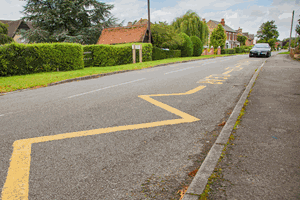
B
C
D
Correct Answer: C
Explanation: Parking here would block the view of the school entrance and would endanger the lives of children on their way to and from school.
Explanation: Parking here would block the view of the school entrance and would endanger the lives of children on their way to and from school.
Correct Answer: D
Explanation: Modern vehicles provide the driver with well-positioned mirrors which are essential to safe driving. However, they cannot see every angle of the scene behind and to the sides of the vehicle. This is why it is essential that you check over your shoulder, so that you are aware of any hazards not reflected in your mirrors.
Explanation: Modern vehicles provide the driver with well-positioned mirrors which are essential to safe driving. However, they cannot see every angle of the scene behind and to the sides of the vehicle. This is why it is essential that you check over your shoulder, so that you are aware of any hazards not reflected in your mirrors.
41. Your vehicle is fitted with a hands-free phone system. Using this equipment whilst driving
Mark one answer
B
C
D
Correct Answer: B
Explanation: Using a hands-free system doesn't mean that you can safely drive and use a mobile phone. This type of mobile phone can still distract your attention from the road. As a driver, it is your responsibility to keep yourself and other road users safe at all times.
Explanation: Using a hands-free system doesn't mean that you can safely drive and use a mobile phone. This type of mobile phone can still distract your attention from the road. As a driver, it is your responsibility to keep yourself and other road users safe at all times.
42. You are parking your car. You have some valuables which you are unable to take with you. What should you do?
Mark one answer
B
C
D
Correct Answer: A
Explanation: Your vehicle is like a shop window for thieves. Either remove all valuables or lock them out of sight.
Explanation: Your vehicle is like a shop window for thieves. Either remove all valuables or lock them out of sight.
Correct Answer: B
Explanation: The anti-lock braking system has sensors that detect when the wheels are about to lock. It releases the brakes momentarily to allow the wheels to revolve and grip, then automatically reapplies them. This cycle is repeated several times a second to maximise braking performance.
Explanation: The anti-lock braking system has sensors that detect when the wheels are about to lock. It releases the brakes momentarily to allow the wheels to revolve and grip, then automatically reapplies them. This cycle is repeated several times a second to maximise braking performance.
Correct Answer: A
Explanation: If your car is fitted with anti-lock brakes they will take effect when you use them very firmly in an emergency. The system will only activate when it senses the wheels are about to lock.
Explanation: If your car is fitted with anti-lock brakes they will take effect when you use them very firmly in an emergency. The system will only activate when it senses the wheels are about to lock.
Correct Answer: D, E
Explanation: Coasting is when you allow the vehicle to freewheel in neutral or with the clutch pedal depressed. Doing this gives you less control over the vehicle. It's especially important not to let your vehicle coast when approaching hazards such as junctions and bends and when travelling downhill.
Explanation: Coasting is when you allow the vehicle to freewheel in neutral or with the clutch pedal depressed. Doing this gives you less control over the vehicle. It's especially important not to let your vehicle coast when approaching hazards such as junctions and bends and when travelling downhill.
Correct Answer: B
Explanation: The emphasis is on hazard awareness and planning ahead. By looking well ahead you will have plenty of time to deal with hazards safely and won't need to brake sharply. This will also reduce damage to the environment.
Explanation: The emphasis is on hazard awareness and planning ahead. By looking well ahead you will have plenty of time to deal with hazards safely and won't need to brake sharply. This will also reduce damage to the environment.
47. You are checking your trailer tyres. What is the legal minimum tread depth over the central three quarters of its breadth?
Mark one answer
B
C
D
Correct Answer: B
Explanation: Trailers and caravans may be left in storage over the winter months and tyres can deteriorate. It's important to check their tread depth and also the pressures and general condition. The legal tread depth applies to the central three quarters of its breadth over its entire circumference.
Explanation: Trailers and caravans may be left in storage over the winter months and tyres can deteriorate. It's important to check their tread depth and also the pressures and general condition. The legal tread depth applies to the central three quarters of its breadth over its entire circumference.
48. After passing your driving test, you suffer from ill health. This affects your driving. You MUST
Mark one answer
B
C
D
Correct Answer: C
Explanation: The licensing authority won't automatically take away your licence without investigation. For advice, contact the Driver and Vehicle Licensing Agency (or DVA in Northern Ireland).
Explanation: The licensing authority won't automatically take away your licence without investigation. For advice, contact the Driver and Vehicle Licensing Agency (or DVA in Northern Ireland).
Correct Answer: C, D, E
Explanation: Situations when you MUST stop include the following. When signalled to do so by a police or traffic officer, traffic warden, school crossing patrol or red traffic light. You must also stop if you are involved in an incident which causes damage or injury to any other person, vehicle, animal or property.
Explanation: Situations when you MUST stop include the following. When signalled to do so by a police or traffic officer, traffic warden, school crossing patrol or red traffic light. You must also stop if you are involved in an incident which causes damage or injury to any other person, vehicle, animal or property.
50. You are driving through a tunnel. There has been a collision and the car in front is on fire and blocking the road. What should you do?
Mark one answer
B
C
D
Correct Answer: D
Explanation: If the vehicle in front is on fire, you should pull over to the side and stop. Switch on your warning lights and switch off your engine. If you can locate a fire extinguisher use it to put out the fire, taking great care. Do NOT open the bonnet. Always call for help from the nearest emergency point and if possible give first aid to anyone who is injured.
Explanation: If the vehicle in front is on fire, you should pull over to the side and stop. Switch on your warning lights and switch off your engine. If you can locate a fire extinguisher use it to put out the fire, taking great care. Do NOT open the bonnet. Always call for help from the nearest emergency point and if possible give first aid to anyone who is injured.




